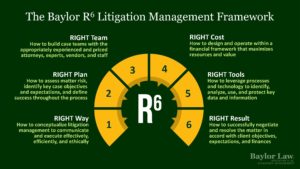Baylor Law’s Executive LL.M. in Litigation Management is the only such program in the country. Their first class in the fall of 2018 included in-house counsel, private practice (from plaintiff and defense firms), and government lawyers who aspire to direct effective litigation strategy. Each successive class in the Baylor Law program followed this formula – lawyers from across the litigation spectrum come together to learn the best litigation management processes. The classes are intentionally small to keep the faculty to student ratio low and allow for a rich learning environment with the candidates and the faculty.

The Baylor R6 Litigation Management Framework, described below, is a core component of Baylor Law’s litigation management approach. It is supported by legal project management methodology. LPM, when applied to the Baylor framework, provides a disciplined process for work breakdown, as well as the allocation of resources and tools. In combination, the Baylor R6 Litigation Management Framework and the LPM methodology optimize results for clients.
At the 2021 Global LPM Summit, Baylor Law professors Kyle Dreyer, Liz Fraley, and Jim Wren discussed early case assessment, decision tree analysis (litigation risk), and damage modeling with conference participants. If you missed this year’s Summit, you can purchase the replays or be sure to sign up early for the next one here.
The Baylor R6 Litigation Management Framework
Legal project management plays a critical role in the Baylor R6, both in the initial planning stage and in the execution. The six parts of the Baylor R6 framework include:
- Right Way: Upon initiation of the matter, management conceptualizes how to communicate and execute in an efficient and ethical manner.
- Right Plan: Management assesses the objectives, clarifies expectations, identifies risks, and defines success outcomes.
- Right Team: The partners build a case team with a blend of resources and the appropriate mix of skills and billing rates.
- Right Cost: The litigation team operates within a financial framework intended to optimize value.
- Right Tools: The litigation team uses tools and technology that expedite the work and secure the data.
- Right Result: The matter is brought to an optimal resolution in accordance with the clients objectives and expectations.
The word ‘right’ has significant implications for how the litigation team operates. It means that all parts of the process are effective, efficient, and ethical while leveraging the necessary people, processes, and technology to obtain the desired outcome for the client. LPM’s rigorous methodology and a disciplined approach help support consistent results at the lowest possible cost.
How Does LPM Work within the Baylor R6 Framework?
Specifically, LPM begins with a stakeholder analysis and scope document. This stakeholder analysis starts with developing a list of stakeholders – those who are affected by or can affect the litigation. From there, the next step is a robust stakeholder analysis. The stakeholder analysis is not always given the attention it deserves. In order to handle a matter the “Right Way”, it is best if you capture an understanding of each stakeholder group’s influence and interest in the process and map out the communication flow. Each group has different communication needs and the success of your strategy may depend on a carefully targeted approach.
The scope document is the confirmation of the client’s objectives and expectations, along with the details of the in- and out-of-scope work, key deliverables, project risks, matter’s constraints, and assumptions. The goal is to outline the work at a high level to ensure you are on the same page with your client and to help the project team stay on track. A properly scoped matter helps the team manage the work and maintain the budget.
Of course, it’s impossible to predict the resolution of every particular case. But a good scope document gives the clients a better idea of what to expect as the case unfolds and helps the litigation team better understand what you need to do to get the best outcome.
The Right Plan
LPM also helps in developing the Right Plan. The full project plan includes a detailed work breakdown structure that activates the scope document. It includes a playbook for the work, risk analysis, communications plan, and more. It breaks down the deliverables into tasks, identifies the correct resource type for the job, and establishes a budget. It’s essentially a compendium of who does what, when, and where.
The Plan is, of course, an essential part of the process, since it informs the Right Team and the Right Cost. It’s where lawyers and in-house counsel must be realistic about the level of effort required and who can do the work. LPM uses the Right Tools like LACI charts that include a task and responsibility matrix to determine the appropriate resources for each line item of the Plan.
Lawyers are increasingly expected to partner with other disciplines and use available technology to manage cost, mitigate risk, and deliver results. Clients demand a realistic budget, one that is credible and transparent. Together, Baylor Law’s R6 Litigation Management Framework and LPM yield the Right Results. It’s a client-centric way to meet your client’s most demanding challenges.
Posted In

